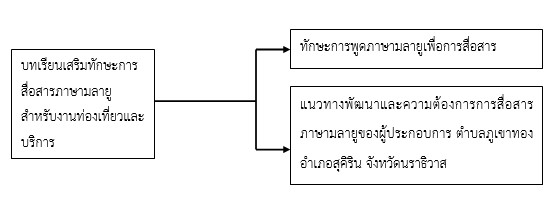Sahidin Nitiphak Enhancing Malay Language Skills Among Entrepreneurs To Create Value For International Tourism At Phukautong, Sukirin, Narathiwat
Main Article Content
Abstract
DOI : 10.14456/pnuhuso.2024.4
The objective of this research were 1) to enhance Malay language skills for the improvement of tourism in the Phu Khaotong sub-district, Sukhirin District, Narathiwat Province, and 2) to synthesize guidelines for the development of Malay language communication skills in promoting tourism in the Phu Khaotong sub-district, Sukhirin District, Narathiwat Province. The sample group consisted of 20 local entrepreneurs in the Phu Khaotong sub-district, Sukhirin District, Narathiwat Province. The research tools consisted were 1) a questionnaire to assess the need for improving Malay language skills, 2) tests and evaluations to measure satisfaction with language training in Malay, and 3) content synthesis based on the findings for activity planning. Statistical analysis of the data included measures such as mean and standard deviation, as well as content analysis to present a narrative summary of the research findings. The research revealed the following: 1) Language skills enhancement in Malay for tourism and service required the presentation of relevant sentences and vocabulary in each lesson, as well as simulated practice in various activities incorporating commonly used Malay language expressions for service provision to Malaysian tourists. 2) Overall satisfaction with the enhancement of Malay language skills for tourism and service was significantly high. 3) Development of Malay language communication skills should be incorporated into the core curriculum structure, encompassing all aspects of service provision. The content should align with the service users' needs and effectively convey a public image for service provision, benefiting the stakeholders in practice.
Article Details

This work is licensed under a Creative Commons Attribution-NonCommercial-NoDerivatives 4.0 International License.
References
กลุ่มงานยุทธศาสตร์และข้อมูลเพื่อการพัฒนาจังหวัด สำนักงานจังหวัดนราธิวาส. (2566). แผนพัฒนาจังหวัดนราธิวาส พ.ศ. 2566 – 2570 (ฉบับทบทวน) ประจำปีงบประมาณ พ.ศ. 2567. สำนักงานจังหวัดนราธิวาส.
กูซม ยามิรูเด็ง. (2561). กลยุทธ์การเรียนภาษา: การเรียนการสอนภาษามลายูในประเทศไทย. อินทนิลทักษิณสาร, 13(ฉบับพิเศษ), 113-127.
ชัชฎา อัครศรีวร นากาโอคะ และกฤชณัท แสนทวี. (2564). การสื่อสารในการส่งเสริมการท่องเที่ยวเชิงสร้างสรรค์ของจังหวัดสระแก้ว. วารสารวิชาการนวัตกรรมสื่อสารสังคม, 9(2), 64-73. https:// ejournals.swu.ac.th/index.php/jcosci/article/view/14087/11410
ณัฐพงศ์ รักงาม. (2559). แนวคิดอัตลักษณ์ท้องถิ่นภายใต้บริบทการเปลี่ยนแปลงในยุคโลกาภิวัฒน์. วารสารวิทยาลัยสงฆ์นครลำปาง. 5(2), 1-14. https://so04.tci-thaijo.org/index.php/NBJ/article/ view/253070/171849
ธญวรรณ ก๋าคำ. (2561). การพัฒนาทักษะการสื่อสารภาษาอังกฤษเพื่อการท่องเที่ยว สำหรับชุมชนกลุ่มธนบุรี กรุงเทพมหานคร. วารสารสารสนเทศ, 17(2), 61-70. https://so03.tci-thaijo.org/index.php/ oarit/article/view/166738/122262
นิลุบล ศรีเทพ. (2563). การพัฒนาหลักสูตรฝึกอบรมภาษาอังกฤษเพื่อการสื่อสารสำหรับการท่องเที่ยว อำเภอเวียงสา จังหวัดน่าน. มนุษยศาสตร์สาร, 21(3), 24-42. https://so03.tci-thaijo.org/index.php/ JHUMANS/article/view/242540/167868
ประพนธ์ เรืองณรงค์. (2558). ชื่อบ้านนามเมืองภาษามลายูในคาบสมุทรภาคใต้ของไทย. ดำรงวิชาการ วารสารรวมบทความทางวิชาการ คณะโบราณคดี มหาวิทยาลัยศิลปกร, 14(1), 11-32. http://www.damrong-journal.su.ac.th/upload/pdf/81_1.pdf
ปวันรัตน์ นิกรกิตติโกศล. (2559). การพัฒนานวัตกรรมการสื่อสารภาษาอังกฤษ สำหรับผู้ประกอบการร้านขายของที่ระลึก ร้านอาหารและเครื่องดื่มที่เกาะเกร็ด จังหวัดนนทบุรี. วารสารสมาคมนักวิจัย, 21(2), 110-122. https://so04.tci-thaijo.org/index.php/jar/article/view/243656/165567
สมนึก เอื้อจิระพงษ์พันธ์, พักตร์ผจง วัฒนสินธุ์, อัจฉรา จันทร์ฉาย และประกอบ คุปรัตน์. (2553). นวัตกรรม: ความหมาย ประเภท และความสำคัญต่อการเป็นผู้ประกอบการ. วารสารบริหารธุรกิจ, 33(128), 57-58. http://www.jba.tbs.tu.ac.th/files/Jba128/Article/JBA128Somnuk.pdf
สํานักการตางประเทศ สํานักงานศาลยุติธรรม. (2563). คู่มือล่ามศาลในคดีค้ามนุษย์. https://oia.coj.go.th/ th/content/page/index/id/203064
Andi, H., Mokhamad, S., Barliana, D. S. & Ade, G. A. (2019). Effectiveness of Entrepreneurship Communication Skills in Business Group: Ethno-Andragogy Approach to Technical Vocational Education and Training. 5th UPI International Conference on Technical and Vocational Education and Training (ICTVET 2018). (pp. 179-182). Atlantis Press. https://doi.org/10.2991/ictvet-18.2019.40.
Best, J.W. and Kahn, J.V. (2006) Research in Education (10th ed.) Pearson Education Inc.: Cape Town.
Čuić Tanković, A., Kapeš, J. & Benazić, D. (2023). Measuring the importance of communication skills in tourism. Economic Research-Ekonomska Istrazivanja. 36(1), 460-479. https:// doi.org/10.1080/1331677X.2022.2077790.
Dewan Bahasa dan Pustaka. (2010). Kamus dewan edisi keempat. Dewan Bahasa dan Pustaka.
Gayathridevi, C.L. (2014). Entrepreneurship in communication and social media. International Journal of Creative Research Thoughts (IJCRT), 2(4), 822-828. https://www.ijcrt.org/ papers/IJCRT1134425.pdf.
Godfrey, K. & Clarke, J. (2000). The Tourism Development Handbook: A Practical Approach to Planning and Marketing. Continuum.
Hsieh, H-F., & Shannon, S. E. (2005). Three Approaches to Qualitative Content Analysis. Qualitative Health Research, 15(9), 1277-1288.
Petpailin, P. (2022, April 26). Thai government promotes the 5 Fs: food, films, fashion, fighting and festivals. The Thaiger. https://thethaiger.com/news/national/thai-govern ment-promotesthe-5-fs-food-films-fashion-fighting-and-festivals.
Seong, T, K. (2013). Dialog Bahasa Melayu:Bahasa Melayu sebagai Bahasa Ilmu Tinggi(Malay Language Dialogue: Malay as a Language of Higher Education). Penerbit UMT.
Sharpley, R., & Telfer, D. J. (Eds). (2002). Tourism and Development: Concepts and Issues.
Channel View Publications.


